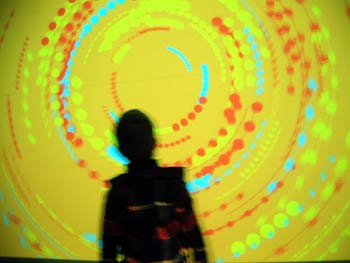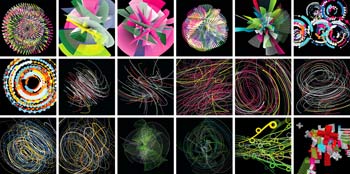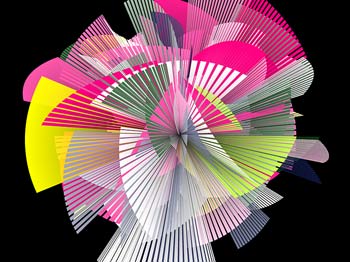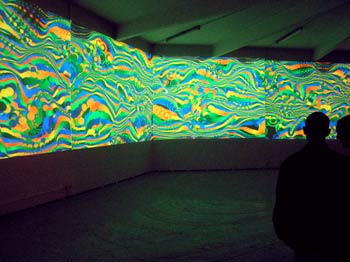fields
électriques
Marius Watz
Originally appeared in Vague Terrain 03: Generative Art
Once Fragments on Generative Art
The following are loose thoughts and tangential fragments commenting on the current state of generative art, my own work and some of the artistic principles involved.


1. code, reductionism and complexity
Working with code can inspire a leaning towards minimalism and formalist thought. Code rewards logic, hierarchy and reductionist thought. Clearly defined structures with established boundaries and controllable parameters yield more reliable results. But while references to minimalism certainly crop up in the current generative art canon, complexity is the more common output. Feeding randomness into a deterministic system quickly produces complex results, and the ability of the computer to execute repetitive instructions enables the simulation of organic material qualities in an otherwise binary and mechanical world.
2. avoid classicism
The logic of computational strategies makes it tempting to make absolute assumptions. Leading figures like John Maeda and Edward Tufte makes strong claims for a “right”way of progressing. The deconstructivist and post-modernist strategies of 90's graphic design may have burned out from running out of fuel, but it has left one important legacy: It's all 1 just a style, and people “read” best what they “read” most. While Maeda's quest for “simplicity” seems noble enough, one would hope tha this goal is not to imprison others in his vision of a simple world.
3. an excess of form
My own work is concerned with exploring semi-autonomous formal systems as a way of creating form that is fluid, complex and simultaneously organic and mechanical. Visually, it is of a hedonist tendency, overflowing with form and color that threaten to break the frame, becoming almost impossible to watch. I am interested in excess, yet the most interesting structures emerge at the edge of chaos 2 , between noise and signal, between far too much
4. yield to external impulses
A central aspect to the generative approach is the use of an externalized system, created by the artist but rarely completely under her control. Standard software tools are deterministic systems that always produce the same results, while generative systems are dynamic processes that must be harnessed and even farmed. The artist specifies the initial boundaries and strategies of creation, and then enters into a feedback loop of adjusting parameters in a search for optimal regions in parameter space. The moment of genuine surprise is often the moment of breakthrough.
5. history and non-history
Nothing exists outside of history. Generative art in its current incarnation has many precursors, some of them direct ancestors and some more distant relatives. Here one could name Constructivism, Cubism, Conceptual art, Op Art etc. The works of Riley, Vasarely and LeWitt are certainly difficult to ignore as a historical precedence.
Artists like Manfred Mohr, John Whitney Sr, Zdenek Sykora, Harold Cohen, Roman Verostko, Jean-Pierre Hebert and the Algorists were among the first to explore code as an aesthetic material, and so can be said to be the original generative pioneers. But to claim a direct lineage is to ignore external influences and the context in which the work was created. It would make more sense to talk of several waves, or if possible even specific groups of artists, with diverse identifiable interests that are both aesthetic and theoretical.
The genealogy of generative art is still being explored, and is important for understanding the field. However, the generation of artists who typically started working around the mid- 90’sshould not be understood as a linear extension of their predecessors. While some interests are shared, other aspects are decidedly new. These fragments deal primarily with the work of the current generation.


6. information and the sublime
Computational information visualization is often presented as the ultimate rational art, and has proven hugely popular with audiences of non-experts. Do audiences experience these works as formulations of absolute truth, or do they understand that while often spectacular, visualizations are often as arbitrary in their aesthetics as paintings? I would like to see an honest appreciation of the art of the database without the pretence of science which often confuses the issue. A good visualization piece (judged both by its target material and its aesthetic and conceptual choices) could then be appreciated as a subjective interpretation, rather than a manifestation of rational truth.
7. oh no, the author died again
Both critics and enthusiasts have claimed that the deliberate loss of control in generative is tantamount to a negation of artistic authorship, enabling the artist to disappear from the work.3
In reality, this is mostly posturing. Even strategies for evolving organic expression independent of the system designer contain a clear fingerprint of the original creator. Harold Cohen's Aaron 4 is a highly sophisticated autonomous system, yet its artistic sensibilities and decision process closely mimic those of Cohen himself.
This debate is similar to the “strong” and “weak” interpretations in the fields of Artificial Intelligence and Artificial Life: Is the resulting system truly intelligent / alive, or is it just a useful simulation of intelligence / living systems. 5
The most fruitful view would seem to be a “weak” model of generative systems, somewhere between the naïve use of undifferentiated randomness to produce unpredictable results and the controlled use of unstable input to simulate organic qualities.
8. problems of theory
Placed within a contemporary art discourse, generative art is not without its problems. Its practitioners often take both aesthetic and philosophical positions (dangerously) close to Modernism or even Abstract Expressionism, making them unpopular with the political / theoretical media art scene. The seemingly similarfield of “software art” has been polemically defined by certain theorists6 as an opposition to generative art. In this scenario, software art purportedly concerns itself with the processes and political aspects of software as a social artifact, while generative art deals only with surface and aesthetics, hiding the code in a "blackbox”and elevating the artist to the genius status seen in Modernism.
This binary opposition does not hold up to scrutiny. However, it is true that generative art generally treats software as a naturalized object, and does not stop to examine its origin in the military-industrial complex, or its value as commercial / social artifact. Code is pragmatically accepted as an optimal material for the investigation of systems and structure, but is often omitted from the final presentation. Due to its symbolic value as a techno-fetishistic object, code becomes a distraction rather than an aid to the appreciation of the work. The work is created from code, but is not about code.
9. abstraction & the aesthetics of complexity
Generative art is rarely concerned with figurative representation. In the few instances where the figurative is featured, it is usually in the form of raw materials (photography or video) for procedural re-interpretation (find examples, Solaas Dreamlines). The following quote by curator Norbert Pfaffenbichler presents a functional definition of abstract art, but could easily serve to describe the majority of generative art output:
“The theme of all abstract art is relations, between individual
elements within the image’s surface
(color and form), between the individual surfaces and between the surfaces and the space in which they exist,
in other words the viewer/user.” 7
Generative art concerns itself with complex systems as and software processes as artistic objects. It is through this vision of complexity that it transports its viewers, hinting at the sublime beyond the ones and zeros.
1 As stated by Zusanna Licko, famous type designer and co-founder of Emigre magazine. This is a reference to an important debate in typography: Is there a universally more readable style of typography, or is readability a matter of social / historical convention? This question should be extended to software metaphors, which have become de facto standards but are not necessarily founded on objective “truth.”
2 The edge of chaos: Term coined by Christopher Langton to describe a region in parameter space where a system hovers between order and chaos, thereby producing the most fruitful complex results.
3 See Leonel Moura's “Symbioticartmanifesto”:
http://www.lxxl.pt/artsbot/
4 See http://www.kurzweilcyberart.com/aaron/history.html
5 http://en.wikipedia.org/wiki/Strong_AI, http://en.wikipedia.org/wiki/Artificial_life
6 InkeArns:“Read_me,run_me,execute_me:Somenotesaboutsoftwareart”,
see http://www.projects.v2.nl/~arns/Lecture/
7 From the catalogue for the “Abstraction Now” exhibition, Künstlerhaus, Vienna 2003. Abstraction Now was important in that it made a convincing connection between image production in media art and established traditions of abstraction.
Marius Watz's biography
